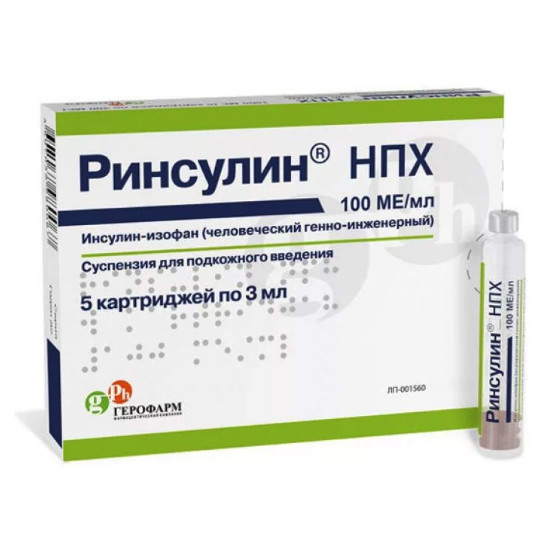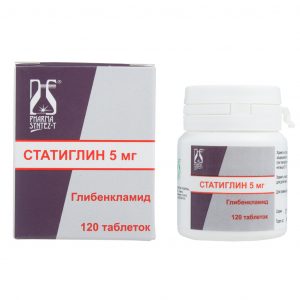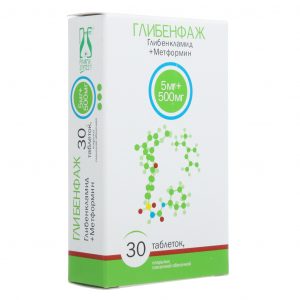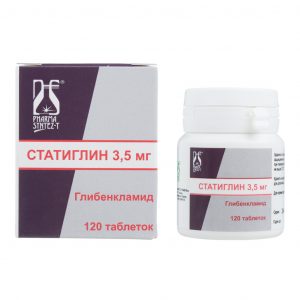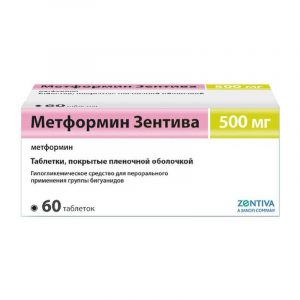Description
Release form
Suspension for subcutaneous administration
Packaging
5 cartridges of 3 ml.
Pharmacological action
RINSULIN NPH – a drug of genetically engineered human insulin. It lowers the level of glucose in the blood, enhances its absorption by tissues, increases lipogenesis, glycogenogenesis, protein synthesis, and reduces the rate of glucose production by the liver.
Is a medium-acting insulin preparation. The onset of the drug after subcutaneous injection after 1.5 hours, the maximum action is between 4 hours and 12 hours, the duration of action is up to 24 hours.
The profile of the drug is dose dependent and reflects significant individual characteristics.
Indications
– Type 1 diabetes mellitus (insulin-dependent)
– Type 2 diabetes mellitus (non-insulin-dependent): stage of resistance to oral hypoglycemic agents, partial resistance to these drugs (combination therapy), intercurrent diseases, surgical interventions (mono – or combination therapy) type 2 diabetes mellitus in pregnant women (if diet therapy is ineffective).
Contraindications
Hypoglycemia, hypersensitivity to human insulin preparations.
Special instructions
Patients receiving more than 100 units of RINSULIN NPH per day when changing the drug should be hospitalized. The transition from one type of insulin to another should be carried out under the control of blood glucose levels.
In connection with the primary purpose of insulin, a change in its type, or in the presence of significant physical or mental stresses, it is possible to reduce the ability to drive a car or to control various mechanisms, as well as engage in other potentially dangerous activities that require increased attention and speed of mental and motor reactions.
The dose of the drug must be corrected when changing the nature and diet, with significant physical exertion, with infectious diseases, surgical interventions, pregnancy, dysfunction of the thyroid gland, Addison s disease, hypopituitarism, renal failure and diabetes in people over 65 years of age. The drug lowers alcohol tolerance.
Composition
active substance:
human insulin 100 IU
excipients: protamine sulfate – 0.34 mg
glycerol (glycerin) – 16 mg
phenol crystalline – 1.65 mg mg
sodium hydrogen phosphate dihydrate – 2.25 mg
water for injection – up to 1 ml
Dosage and administration
s / c.
Intravenous administration of the drug Rinsulin® NPH is contraindicated.
The dose of the drug is determined by the doctor individually in each case based on the concentration of glucose in the blood. On average, the daily dose of the drug ranges from 0.5 to 1 IU / kg (depending on the individual characteristics of the patient and the concentration of glucose in the blood).
Elderly patients using any insulin, including Rinsulin® NPH, are at increased risk of hypoglycemia due to the presence of concomitant pathology and the simultaneous receipt of several drugs. This may make it necessary to adjust the dose of insulin.
Patients with impaired renal and hepatic function are at increased risk of hypoglycemia and may need more frequent insulin dosage adjustments and frequent monitoring of blood glucose.
The temperature of the administered insulin should be at room temperature. The drug is usually injected into the thigh. Injections can also be done in the anterior abdominal wall, buttock or shoulder region in the projection of the deltoid muscle. It is necessary to change the injection site within the anatomical region in order to prevent the development of lipodystrophy.
When s / c administration of insulin, care must be taken not to enter the blood vessel during injection. After the injection, the injection site should not be massaged. Patients should be trained in the proper use of the insulin delivery device.
Rinsulin® NPH cartridges before use should be rolled between the palms in a horizontal position 10 times and shaken to resuspend insulin until it becomes a uniform, turbid liquid or milk. Foam should not be allowed to occur, which could interfere with the correct dose.
Cartridges should be checked carefully. Do not use insulin if it contains flakes after mixing, solid white particles adhered to the bottom or walls of the cartridge, giving it a frozen appearance.
The cartridge device does not allow their contents to be mixed with other insulins directly in the cartridge itself. Cartridges are not intended to be refilled.
When using cartridges with a refillable syringe pen, follow the manufacturer’s instructions for refilling the cartridge in the syringe pen and attaching the needle. The drug should be administered in accordance with the instructions of the manufacturer of the syringe pen.
After insertion, it is necessary to unscrew the needle using the outer cap of the needle and immediately destroy it safely. Removing the needle immediately after injection ensures sterility, prevents leakage, air ingress and possible clogging of the needle. Then put the cap on the handle.
When using multi-dose disposable syringe pens, you must mix the suspension of Rinsulin® NPH in the syringe pen immediately before use. A properly mixed suspension should be uniformly white and cloudy.
Rinsulin® NPH in a pen cannot be used if it has been frozen. When using pre-filled multi-dose disposable syringe pens for repeated injections, it is necessary to remove the syringe pen from the refrigerator before first use and let the drug reach room temperature. The exact instructions for use of the syringe pen supplied with the drug must be followed.
Rinsulin® NPH in the syringe pen and needles are for personal use only. Do not refill the syringe pen cartridge.
Needles should not be reused.
To protect against light, the syringe pen should be closed with a cap.
Do not store the used syringe pen in the refrigerator.
Rinsulin® NPH can be administered either alone or in combination with short-acting insulin (Rinsulin® P).
Store the drug in use at room temperature (15 to 25 ° C) for no more than 28 days.
Use of cartridges using reusable syringe pens
Cartridges with Rinsulin® NPH can be used with reusable syringe pens:
– Autopen Classic 3 ml 1 Unit (121 units) AN3810, Autopen Classic 3 syringe pen ml 2 Unit (242 units) AN3800) manufactured by Owen Mumford Ltd., Great Britain
– pen injectors for insulin administration HumaPen® Ergo II, HumaPen® Luxura and HumaPen® Savvio manufactured by Eli Lilly and Company, USA
– insulin pen OptiPen® Pro 1 manufactured by Aventis Pharma Deutschland GmbH / Germany
– syringe pen BiomaticPen® manufactured by Ipsomed AG / Ypsomed AG, Switzerland
is a pen-injector for insulin administration individual RinsaPen I manufactured by Ipsomed AG / Ypsomed AG, Switzerland.
Carefully follow the instructions for using the syringe pens provided by their manufacturers.
Side effects
Due to the effect on carbohydrate metabolism: hypoglycemic conditions (pallor of the skin, increased sweating, palpitations, tremors).
Allergic reactions: extremely rare – skin rash.
Local reactions: lipodystrophy at the injection site (with prolonged use).
Other: transient refractive errors (usually at the start of therapy).
Drug interaction
The hypoglycemic effect of Rinsulin is enhanced by MAO inhibitors, non-selective beta-blockers, sulfonamides, anabolic steroids, tetracyclines, clofibrate, cyclophosphamide, fenfluramine, and preparations containing ethanol.
Oral contraceptives, glucocorticosteroids, thyroid hormones, thiazide diuretics, heparin, lithium preparations, tricyclic antidepressants reduce the hypoglycemic effect of the drug.
Under the influence of reserpine and salicylates, both weakening and enhancing the action of the drug are possible.
Overdose of
With an overdose of the drug, a hypoglycemic condition may develop.
The initial symptoms of a hypoglycemic state are sudden increased sweating, palpitations, tremors, hunger, agitation, paresthesia in the mouth, pallor, headache.
In severe cases of overdose, hypoglycemic coma may develop.
Treatment: the patient can eliminate mild hypoglycemia by ingesting sugar or carbohydrate-rich foods.
In severe cases, 20-40 ml of a 40% glucose solution is administered intravenously, 1 mg of glucagon intramuscularly.
Storage Conditions
In a dark place at + 2 ° C to 4-8 ° C. Do not allow freezing.
Deystvuyuschee substances
Insulin-yzofan chelovecheskyy genetically Inzhenernyi
